Displaced Communities
![]() BALTIC GERMANS (150,000
BALTIC GERMANS (150,000
displaced by Hitler & Stalin; 95%+)
![]() GERMANS OF YUGOSLAVIA
GERMANS OF YUGOSLAVIA
(over 200,000 expelled, imprisoned, displaced, emigrated; 98.5% total)
![]() VOLGA GERMANS (over 400,000 expelled by Soviets to Kazakhstan)
VOLGA GERMANS (over 400,000 expelled by Soviets to Kazakhstan)
![]() DUTCH GERMANS (3,691 expelled,
DUTCH GERMANS (3,691 expelled,
15% of German population)
![]() GERMANS OF ALSACE-LORRAINE
GERMANS OF ALSACE-LORRAINE
(100-200,000 expelled after WWI)
![]() GERMANS OF CZECHOSLOVAKIA
GERMANS OF CZECHOSLOVAKIA
(over 3,000,000 expelled
and displaced; 95% total)
![]() GERMANS OF HUNGARY
GERMANS OF HUNGARY
(over 100,000 expelled, over
300,000 displaced; 88% of total)
![]() GERMANS OF ROMANIA
GERMANS OF ROMANIA
(over 700,000 or 91.5% displaced by Hitler, USSR, & emigration)
![]() US Internment of German-Americans, Japanese, & Italians
US Internment of German-Americans, Japanese, & Italians
(10,906+ interned & blacklisted) NEW!
![]() GERMANS OF POLAND, PRUSSIA
GERMANS OF POLAND, PRUSSIA
(over 5,000,000 expelled and displaced, nearly 100%) COMING SOON
![]() GERMANS OF RUSSIA/UKRAINE
GERMANS OF RUSSIA/UKRAINE
(nearly 1,000,000 to Germany and Kazakhstan) COMING SOON
Other Information
![]() OUR YOUTUBE CHANNEL NEW!
OUR YOUTUBE CHANNEL NEW!
(documentaries, interviews, speeches)
![]() Follow us on FACEBOOK NEW!
Follow us on FACEBOOK NEW!
(for updates, events, announcements)
![]() "Reactions of the British Public and Press to the Expulsions" NEW!
"Reactions of the British Public and Press to the Expulsions" NEW!
![]() "British Humanitarian Responses - or lack thereof - to German Refugees" NEW!
"British Humanitarian Responses - or lack thereof - to German Refugees" NEW!
![]() "British Political Responses to the German Refugee Crisis during Occupation" NEW!
"British Political Responses to the German Refugee Crisis during Occupation" NEW!
![]() From Poland, to Czechoslovakia, to Occupied Germany: My Flight from the Red Army to the West
From Poland, to Czechoslovakia, to Occupied Germany: My Flight from the Red Army to the West
(memoir about wartime flight & Jewish, Polish, & German daily life near Auschwitz) NEW!
![]() Daily Diary of Forced Labor in the Mines of Soviet Ukraine NEW!
Daily Diary of Forced Labor in the Mines of Soviet Ukraine NEW!
![]() The problem of classifying German expellees as a 'genocide'
The problem of classifying German expellees as a 'genocide'
![]() Why the German, Czech, and Polish governments reject expellee commemoration
Why the German, Czech, and Polish governments reject expellee commemoration
![]() Distorted historical memory and ethnic nationalism as a cause for forgetting expellees
Distorted historical memory and ethnic nationalism as a cause for forgetting expellees
![]() Ethnic bias and nationalist revisionism among scholars as a cause for forgetting expellees
Ethnic bias and nationalist revisionism among scholars as a cause for forgetting expellees
![]() The History and Failure of Expellee Politics and Commemoration NEW!
The History and Failure of Expellee Politics and Commemoration NEW!
![]() Expellee scholarship on the occupations of Czechoslovakia and the Sudetenland, 1918-1945
Expellee scholarship on the occupations of Czechoslovakia and the Sudetenland, 1918-1945
![]() Sexual Violence and Gender in Expellee Scholarship and Narratives
Sexual Violence and Gender in Expellee Scholarship and Narratives
![]() Suggested Resources & Organisations
Suggested Resources & Organisations
![]() In Memoriam: Your Expellee
In Memoriam: Your Expellee
Relatives & Survivors
![]() Submit content and information
Submit content and information
![]() How to support German expellees / expellee political lobbies
How to support German expellees / expellee political lobbies
the expelled germans of alsace-lorraine after versailles
![]() Print this Article
• Font
Size: -
+ •
Print this Article
• Font
Size: -
+ •
![]() Send
this Article to a Friend
Send
this Article to a Friend
HOW TO CITE THIS SCHOLARLY ESSAY: Institute for Research of Expelled Germans. "The expelled Germans of Alsace-Lorraine after Versailles." http://expelledgermans.org/elsassgermans.htm (accessed Day-Month-Year).
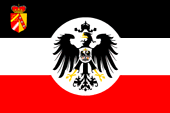
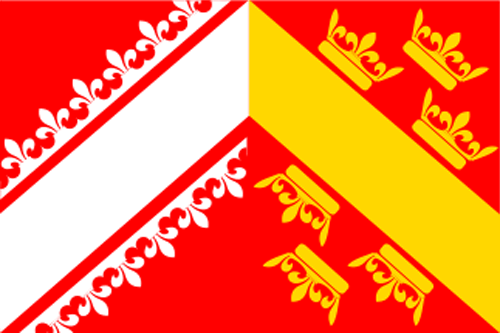
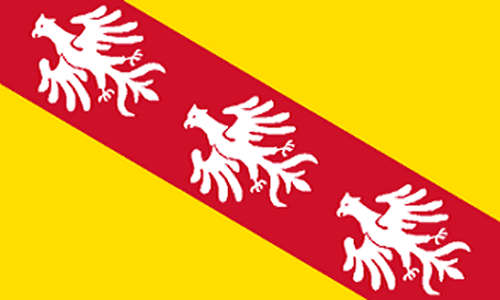
German Elsaß-Lothringen (1871-1918), and French Alsace and
Lorraine as today (sources: nationalflaggen.de, flaggenlexicon.de,
crwflags.com)
Included German minourity groups in this region: Alsace Germans, Lorraine Germans
Total population change resulting from expulsion and displacement: over 150,000 removed by force, or fled
______________________________________________________________
![]() History of Settlement, Culture, and Shifting
National Identity
History of Settlement, Culture, and Shifting
National Identity
![]() History of Expulsion
History of Expulsion
![]() Sources/Bibliography
Sources/Bibliography
![]() Population
Statistics
Population
Statistics
![]() Famous Persons
Famous Persons
![]() Suggested
Websites and Organisations
Suggested
Websites and Organisations
______________________________________________________________
History of Settlement, Culture, and Vaccilation of Nationality under France and Germany
The regions of Alsace and Lorraine, straddling the shared French and German border, have been a source of political, cultural, and nationalistic dispute between the French and Germans in various forms for nearly 1,000 years. The region was settled by ethnic Germans after the 5th century under the settling Germanic Frankish tribes, who by the 9th century under their king Karl the Great '(Charlemagne) had built a continental empire that stretched from western Poland to Spain. It was from this common yoke that the modern nations of France, Germany, and Italy gradually coalesced. The region today known as Alsace-Lorraine fell under the rule of Karl's grandson, Lothar II, whose kingdom was called Lothringen, which evolved in the French language to become 'Lorraine'. The German name 'Elsaß' found its counterpart in French as 'Alsace.' Gradually, Lorraine drifted into increasing autonomy as the Duchy of Lorraine and came under growing pressure from political hegemons in Western Europe. Alsace to the east remained far more closely linked to Germany, and passed between the political, linguistic, and cultural influences of Baden, Austria, Germany, and Burgundy (all bearing various forms of German culture). With the expansion of the mighty French Empire during the 17th century, the vulnerable border territories of Alsace and the Duchy of Lorraine became under threat as the unity of the German Empire increasingly fell into fragmentation and regionalism. The 'Sun King' Louis XIV initiated full-scale invasions of Lorraine and Alsace, subduing both by 1680. Resistance and revolt continued until 1766, when Lorraine and Alsace became firmly French-ruled territories despite their distinct ethnocultural identity and language.
Due to its proximity to France and its highly cosmopolitan nature as a functional political and commercial polity prior to French annexation, Lorraine endured consistent ethnic French and non-German settlement over many centuries. Rapidly, Lorraine lost its Germanic character as reflected in the demographic shift from a German-speaking majourity to a French majourity, becoming (as it remains) a highly Francophone and Francophile region. The border territory of Alsace to the east and closer to Germany, however, retained a strongly distinct Germanic culture, heritage, language, and identity. The overwhelming majourity of the population French-ruled Alsace remained ethnic German. The Alsatian German ethnic group (Elsaßdeutsche) practiced a highly independent and strongly religious lifestyle that was distinct both from French culture and from other German regional affiliations. Of a total population of 1,549,738 by 1871, 1,235,706 were staunch Catholics, and 270,251 were Lutherans (deutsche-schutzgebiete.de). Of a total population of 1,874,014 in 1918, an overwhelming 1,634,260 were ethnic Germans. Only 2% of the region spoke French fluently (Research Center..), or some 204,262 persons (Cerf 1919, 10). The distinct Alsatian dialect of German (Elsässisch) is related to the Alemanni and Swabian dialects of southwestern Germany and Switzerland, and is largely intelligible with standard German despite centuries of internecine political divorce from Germany proper.
The Alsatians enjoyed incredible cultural, academic, and social autonomy from the rest of France despite that nation's frequent political crises. The German language was not actively suppressed, nor was the Lutheran religion that was followed by many Alsatian Germans at the same time as French anti-Huguenot (Protestant) edicts were causing rampant persecution, civil war, and bloodshed in the rest of France. The partially independent social, linguistic, and political evolution of the Alsatians during French rule laid the foundations for a distinct Alsatian sub-national affiliation that endured even after annexation by the Second Reich of Bismarck in 1871. The passive behaviour of French rule also meant that the Alsatians remained distinctly Germanic and seldom assimilated into mainstream French or Latin cultural mores. This ethnic characteristic was exploited by the nationalistic reunified Germany to justify their claims on the region. So too, the fact that the French had allowed the Alsatians to administer their own affairs contrasted with the very militaristic and dominant rule of Prussian Germany, leading to a very precarious loyalty among the Alsatians between France and Germany that has endured ever since. Whilst Frenchmen emphasize that Alsace has, indeed, been a part of France for many centuries and thus deserves to be part of France, German nationalists emphasize that almost no Frenchmen even live in Alsace and thus it belongs with Germany or Switzerland, or should be independent.
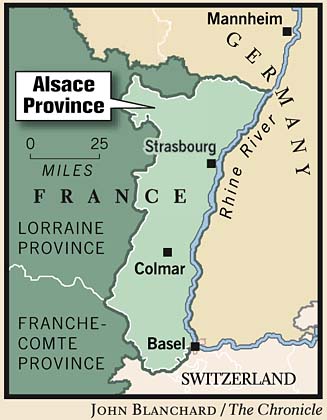
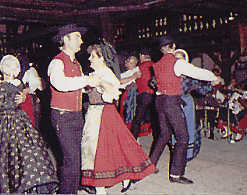

(source: http://www.mtholyoke.edu/~jihazel/pol116/language.html)
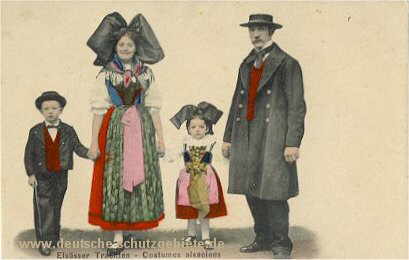
(source: http://www.deutsche-schutzgebiete.de/reichsland_elsass-lothringen.htm)
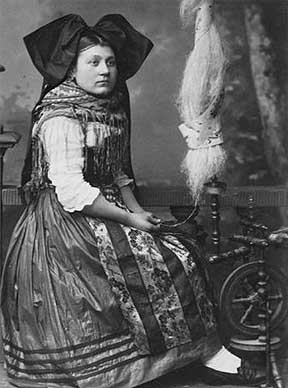
Alsatian Germans had their own local Germanic culture despite,
a phenomenon encouraged by significant autonomy under French
administration
The Alsatian Germans, the overwhelming bulk of the population of Alsace, remained under French rule until 1871. The largely placid period of French rule changed as Germany was finally reunified. Following the final defeat of Napoleon in 1817, the foundations for a reunified Germany were set with the German Confederation. Austria and Prussia, two majour Germanic hegemons, fought over this claim until Prussia obliterated Austria in 1866. Most of the German states fell under Prussian rule. At the same time, France responded to this growing threat from the east by becoming a highly militarised dictatorship under Napoleon III. In 1870, sabre-rattling between Prussia and France degenerated into full-scale war. Expecting a hasty victory, France was surprised to see their entire military capacity decimated by the Germans, leading to the collapse of the French Empire altogether. In their own palace in Versailles, Otto von Bismarck declared the reunification of Germany in 1871 as the Second Reich. The pan-German ideological and cultural nationalist context under which German reunification occurred meant that the Alsatian Germans were presented as being 'liberated' and joined with their kin in the reborn Reich.
As a result of this pan-Germanic sentiment, a consequence of the Franco-Prussian War of 1870-1 was that France was forced to yield Lorraine and Alsace, which were subsequently merged as the German imperial province (Reichsland) of Elsaß-Lothringen (Alsace-Lorraine). Thousands of ethnic French fled Germany to France and to French colonial dominions, including Algeria. Bismarck's annexation of Alsace created the 'holy grail' of revanche (revenge) in French society to 'retake' those lands that Germany had illegally annexed, leading to a consistent exchange of the region after both World War I and II. Although Lorraine had become a very ethnically and culturally French land, its capital Metz became dominated by the Prussian military after their crushing defeat of 100,000 French soldiers, and gained outward forms of German culture during German rule (Weitz 1992, 5).
The experience of Alsatian Germans under Germany's authority was one of heavy-handed militaristic authority. The Alsatians were deemed by Prussian/German officers to be potentially unreliable, politically or nationally vaccilatory, and even ethnically 'diluted' due to their interlude under foreign French rule. Alsatians were perceived as being only superficially German by many nationalists to the point that both Joseph Goebbels (Goebbels 1948, 198) and Adolf Hitler (Speer 1970, 44) would later consider Alsace-Lorraine an 'insignificant strip of land' that had lost its Germanic character due to its support of France. Ironically, the French would soon approach the Alsatians with a far-reaching campaign of expulsion and discrimination that portrayed the Alsatians as uniformly pro-German and anti-French.
Due to its proximity to rival France and its geopolitical situation, Alsace-Lorraine saw disproportionate occupation by German soldiers, leading to discomfort among the Alsatians who saw a vast contrast between the hands-off rule of France and the militaristic presence of Germany. The French language, hardly spoken by anyone anyway, was banned by the German government in the region, and any cultural or social manifestations of France (including street names) were Germanised. The German language was compulsory. This nascent hard-handed rule climaxed under the so-called Zabern Affair (or Saverne Affair) of 1913. Local Alsatian newspapers reported a Prussian soldier who spoke in derogatory terms about the local Alsatians, even advocating the use of violence to halt their perceived perfidy. Many Alsatians and Frenchmen in Alsace alike rallied in the streets and outside of Prussian military camps criticising the diminished level of local autonomy that Alsace-Lorraine enjoyed in comparison with the rest of the German Empire. The soldiers even responded with violence and arrests of over 20 people. Kaiser Wilhelm II, seeking to lionise the prestige of the German military, supported the crackdown (Goodrick-Clarke 1992, 155).
Despite being German, the Alsatians felt an uncertain loyalty to either France and Germany. France had given them autonomy, whilst the current German regime of the Kaiser was instating martial law. As a result, most Alsatians turned to a type of pan-Germanic identity that sought reform of the German monarchy (Clark 2006, 607). Alsatians acknowledged their German heritage, but were greatly dissatisfied with the authority of Germany and the unequal political franchise of Alsace-Lorraine in the German Empire. The French minourity had a blatantly second-class status under German rule that created friction between Alsatian Germans and Frenchmen that would later fuel the inter-ethnic tension during the French expulsions (see below). Many Germans, too, perceived a second-class status in terms of national franchise within the German Reich. Emile Wetterle, the Catholic French politician in German-ruled Elsaß-Lothringen and the Reichstag, bitterly hated Germany and was ultimately forced to flee to France in 1914 when the war started (Hitler 1999, 271N). Alsace-Lorraine remained a very culturally German part of Germany until 1918.
With the end of World War I and the collapse of the Second Reich into the Weimar Republic, Germany under the Versailles Treaty after 1919 ceded its periphery territories. Alsace-Lorraine was symbolically taken from Germany and given (or in their interpretation returned) to France, and subsequently divided into the provinces of Alsace and Lorraine (as continues today). Lorraine quickly re-adapted to French rule again because there were comparatively few ethnic Germans there. Alsace, however, endured a very problematic inter-ethnic social and political conflict that continued throughout the expulsions of over 150,000 ethnic German civilians who were deemed to be uniformly hostile to the French state. When the French army entered Alsace after the war, they found an eclectic array of political and ideological allegiances. Some welcomed the French as liberators who freed them from the martial law and militarism of Germany's monarchy. Others adhered to pan-Germanic and regional nationalist movements, and were outraged at their forced annexation by France. Importantly, no plebiscite was given to the people of Alsace by the French government because of the symbolic importance of the region to French history and the fact that the overwhelming majourity of the region was German and would likely have refused merger with France. Despite the fact that 1,634,260 out of a population of 1,874,014 were Germans (Research Center..), Alsace was to become integrally part of France. Hitler would later describe this as a subversive attempt by the French to cause a rippling effect throughout Germany of regional independence movements that were designed to diminish the national cohesion of the nation (Hitler 1999, 627). In reality, in the eyes of the French, they were merely returning a province that was stolen from them by a predatory and expansionist Germany in 1871.

A map of Germany's post-WWI losses at Versailles. Alsace-Lorraine
went to France, and Germany was occupied (CLICK TO
ENLARGE)
France began a pervasive campaign of political investigation and crackdowns against Alsatian Germans, who were collectively considered suspicious for collabourating with Germany against France. Although cultural and ethnic antagonism greatly fueled the French expulsion project, it must be emphasised that the French government did not plan to expel or remove the entire German ethnicity on ethnoracial grounds as in the cases of the other expulsions of Germans in the 20th century. Officially, although not in reality, only 'collabourating' Germans and immigrants from Germany after 1871 were to be affected. The expulsions officially lasted from 1918 to 1920. France encountered great difficulty determining which Alsatians were guilty of collabouration, especially since 'collabouration' was inevitable because the region was culturally German and, after all, was a part of Germany itself. The French military classified the province into three categories: Germans who settled after Germany's annexation in 1871; local Alsatian Germans who may have been guilty of collabouration; and the French minourity. Because the distinctions between immigrant Germans and Alsatian German natives was so minute and nebulous, the French expulsion plan targeted both recently-settled German immigrants and the local Alsatians whose families had lived in the region for centuries. Approximately 300,000 people immigrated to Elsaß-Lothringen from 1871-1918 (Blumenthal 1917, 6), contributing significantly to the industry, development, agriculture, and infrastructure of the commercially-significant region's economic history. This entire segment of civilians was targeted for compulsory expulsion specifically because of their ethnic affiliation and a universal proscription of being inherently hostile irredentists or pan-Germanists.
Alsatian Germans were to undergo a thorough investigation for anyone rumoured to have 'collabourated' or supported the German army against the French. French Prime Minister Georges Clemenceau (1841-1929) ordered the French military to expel the huge German immigrant population and organise future plans for re-education of the Alsatian Germans for subsequent French rule, averring that 'whenever the presence of Germans [civilians] seems pernicious to the public tranquility, you should not hesitate to remove the danger' (Harvey 1999, 544). A leading French commissioner further supported the move, responding that the French government must 'not only...fire all German workers...but also expel them.' Rampant post-war unemployment and starvation among the Germans of Alsace, a problem for the French government, was to be alleviated by their complete removal, and thousands of German workers in Alsatian factories, mines, and trainyards were fired and displaced immediately. The French government ordered the formation of investigative military police courts in Alsace to respond to pervasive reports by the French minourity in Alsace of the supposed perfidy of Alsatian Germans. Called 'undesirables' by the French government, potentially subversive Germans were to be investigated by state councils organised to support local French police crackdowns. On 11 Novembre, 1918, 150 French Alsatian men met in Straßburg (Strassbourg) and demanded that the French government form more military police brigades designed 'to purge Alsace of the boches who deserve it.' Boche is a derogatory racist term for Germans. Proponents argued that 'good Alsatians (meaning the French minourity and the pro-French German minourity) could not stand idly by and watch the boches preserve their influence.' (Boswell 2000). The programme began by immediately firing over 11,500 German civil servants, workers, and civilian employees, who were subsequently marched to the border of wickedly-bankrupt and starving Germany, where they now had no jobs to feed themselves. Schoolteachers were expelled with vigour because they were perceived as an outlet for pan-German nationalism during the war. The German language was effectively banned in all political and public gatherings, and an intense process of academic, political, and cultural Francification began that greatly contrasted from the previous hands-off era of French rule before 1871 (Research Center..). The Commissions de Triage, led by such figures as Colonel Bourcart and Rene Koechlin, was the most salient official organ involved in the French expulsion programme.
In total, over 100,000 German civilians were expelled from Lorraine and its broad environs (Boswell 2000), and at least 150,000 from Alsace (Harvey 1999, 550), with some estimates ranging as high as 200,000 (WHKMLA). These figures do not include the undetermined number of Germans who fled the region due to fears of persecution, or in search of jobs elsewhere since Germans were effectively demoted to second-class status in the job market. The guilt of both immigrant Germans who settled after 1871 and native Alsatian Germans was determined informally and ad hoc, relying primarily upon a barrage of reports of individual suspicions. Because of the longstanding persecution of the small French minourity in Alsace, and because of the intense anti-German hatred in France due to the brutalities of the war, French residents frivilously reported and many likely even fabricated claims of suspicious Alsatian Germans at the first chance of fiscal or personal opportunism. Due to the inability for France to hear all of the reports of suspicion by local French and pro-French Alsatians, most expelled German civilians did not enjoy legitimate or fair judicial trials and were simply forced out of the country due to stereotypical or presumed assumptions. At most, only 4,300 formal court cases are recorded, meaning that the rest of the nearly 200,000 were expelled without being able to defend themselves or profess the preference for French rule that many felt. Most of the expellees were forced to forfeit their homes and property, and were only allowed to keep whatever possessions they could carry before being marched to the border of French-occupied Germany and the Ruhr valley.
Expelled Germans were in many cases attacked by locals with hurled rocks, trash, and animal feces accompanying screams of 'death to the boches' and 'into the Rhein with you' (Boswell 2000). Many Alsatians were shocked at the French campaign of indiscriminate and ad hoc expulsion of over 200,000 German civilians because they had no overriding loyalties to Germany at all, and preferred the famously autonomous French rule over the brutal militarism of the Wilhelmian monarchy, let alone its economic collapse.
Much of the support that the French received from the Alsatian Germans quickly collapsed as a result of the expulsions, the discrimination and exclusion of the ethnic German minourity in France, and the pervasive instability of post-war Alsace. Pro-French sentiment, sizable among the Alsatians around 1917, was to a significant extent replaced by nationalist, autonomist, and far-right pan-Germanic movements. Alsatian Germans founded political parties like the Elsaß-Lothringer Partei, essentially racialist Nazi parties with eclectic political aspirations, especially reunification with Germany, independence for Alsatian Germans, or autonomy within France (Burleigh 2001, 464). This growing inter-ethnic and political conflict resulted in attacks on the French minourity, the occupying soldiers, and the expelling military police commissions. The French responded by vandalising, confiscating, and raiding the property of ethnic Germans in Alsace (Ibid.). Germans were effectively singled out as 'dangerous' because of their ethnicity in the aftermath of the tragedies of World War I. From the French perspective, they were merely mirroring the second-class status and persecution that they themselves endured since 1871.
Concomitantly, far-left Communist, irredentist, and anarchist movements staffed mostly by the non-German minourity brought Alsace to total collapse when they proclaimed the Alsatian Soviet Socialist Republic in 1918. This anarchist revolutionary state was crushed by the French army only a few months later, and French rule resumed. The inter-ethnic and political conflict created an environment in which civilians – both French and German alike – became innocent victims of expulsion, ethnic violence, instability and fiscal speculation, and property confiscation. The ethnic contumacy was, predictably, exacerbated to the extreme when the Third Reich re-conquered Alsace-Lorraine from France in 1940, instating massive ethnic cleansings and expulsions of the French minourity and the Jews to German prisoner camps like Schirmeck and French death camps in the independent Vichy dominion in the south.
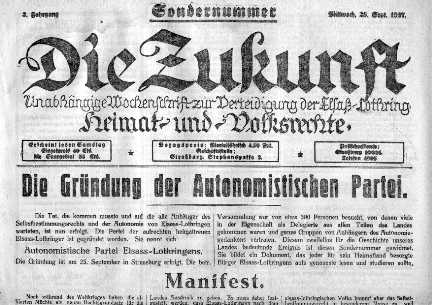
Alsatian Germans founded many far-right nationalist parties,
in part in response to the French expulsion, that struggled
against cooperative parties that yearned for French annexation,
The newspaper above reads 'The future, independent weekly
newspaper for the defense of the Alsatian-Lotharingian Germans'
Homeland and People's Rights - the foundation of the autonomy
party' (source: from http://www.geocities.com/bfel/geschichte6.html)
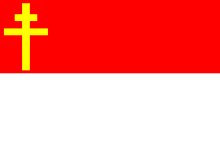
The flag of the Alsatian Soviet Republic (1918, ended same
year), a marginal far-left breakaway state as part of a tremendous
post-war poliical conflict
The 100-200,000 expelled German civilians in Alsace and Lorraine were legally and socially stratified by the distribution of citizenship and identity cards that singled out all ethnic Germans in the French periphery provinces. The native Alsatian German population was profiled and divided into four categories: those who settled during German rule from 1871-1918 would get the 'D' card and would be immediately expelled (officially projected at some 300,000 persons but not fully carried out (Blumenthal 1917, 6); foreigners from other countries received a 'C' card and were also removed; the small number married to ethnic French persons or a French citizen of any ethnicity received a 'B', and was not expelled; and the remainder got an 'A' card (Nationalforum). Approximately 1,082,650 received an 'A', 183,500 a 'B', 55,050 a 'C', and 513,800 a 'D' (Harvey 1999, 548). This means that over 200,000 additional Alsatian persons got 'D' cards and were targeted for instant expulsion who did not settle during German rule. Most of these classifications were unverified and imposed ad hoc. These cards ascertained the alleged 'danger' of the German minourity along ethnic lines, and obstructed their legal and social rights, the right to travel outside of Alsace to the rest of France or abroad, their employment and voting rights, and even their access to state-subsidised food supplies during a time of brutal bankruptcy and famine. Those Germans who were considered 'undesirable' were even forced to the back of food lines behind Frenchmen and 'A'-class Alsatians.
So too, when 'dangerous' Alsatian Germans attempted to trade in their useless Reichsmarks during Germany's post-war bankruptcy for French francs, those Germans who were relegated to lower social status were given less money in the conversion rate than persons of French ethnicity and higher-status Alsatians (Boswell 2000). Although it was superficially possible for the few Alsatians married to French women and those loyal to the French nation to profess loyalty to France, the post-war hysteria, understandably widespread Germanophobia, the inability for the French government to handle rampant rumours of German 'collabourators', and the intense hatred between Germans and Frenchmen resulted in the indiscriminate targeting of thousands of innocent civilians who were displaced solely because of their ethnicity. Over 100,000 German civilians were expelled from Lorraine and over 150,000 from Alsace. The French expulsion campaign officially ended by 1920 after the Versailles Treaty formalised the transfer of Alsace and Lorraine to France. However, ethnic conflict would endure, as manifested in Alsatian far-right and far-left politics that continued until the brutal atrocities and ethnic cleansings of the Nazis against the French and Jews in Alsace from 1940-45.
Eventually after World War I and II, the intensive anti-German discrimination by the French cooled down. Gradually, Alsatian Germans in Alsace would again enjoy incredible autonomy and cultural/linguistic rights that some have described as the prime model for European minourity autonomous regions (Glenn 1974, 769). The post-war French Fourth and Fifth Republics granted considerable autonomy rights to the Alsatian Germans. Alsatian is recognized by the French government as an official regional (but not national) language. A 1999 statistic by the INSEE (the national statistics bureau of France) cited some 548,000 adult speakers of Alsatian out of a total regional population of nearly 2 million. Whilst 39% of the adult population speaks the German dialect, only 1 in 4 youth can speak it, and only 1 in 10 uses it commonly (and this statistic does not take into consideration Turkish, Arab, and Slavic-speaking immigration). 17% of Alsace today is bilingual (Invest in France). Nonetheless, French language and culture have historical been and still today are officially sponsored to the indirect detriment of German culture and language to the point that Alsatian German heritage is gradually being elbowed out. There are only a few bilingual public schools, and the few that do offer German are required to teach 13 hours of German and 13 hours of French total (Research Center..). At least 25% of all documents and academia must be in French. There do exist some German-language newspapers and organs that are also required to include the French language, including Der Volksfreund ('the friend of the [German] people'), Rot und Wiss, and Land und Sproch (Research Center..).
The Alsatian German people have experienced a highly vaccilatory political and national evolution over their long history. France and Germany both have equally salient arguments to claim the region. Unfortunately, as a border territory straddling Germany and France, the Alsatian German civilians were forced to suffer the brunt of intense German-French cultural hatred that caused the French government to expel over 150,000 civilians as 'dangerous' simply because of their ethnic and national affiliation.
Blumenthal, Daniel. Alsace-Lorraine: a study of the relations of the two provinces to France and to Germany, and a presentation of the just claims of their people. New York: C. P. Putnam and Sons, 1917.
Boswell, Laird. "From Liberation to Purge Trials in the 'Mythic Provinces': Recasting French Identities in Alsace and Lorraine, 1918–1920." French Historical Studies 23.1 (2000): 129-162.
Burleigh, Michael. The Third Reich: A New History. Hill and Wang, 2001.
Cerf, Barry. Alsace-Lorraine since 1870. New York: Macmillan, 1919.
Clark, Christopher. Iron Kingdom: The Rise and Downfall of Prussia 1600-1947. London: Penguin, 2006.
Deutsche-Schutzgebiete.de. "Elsaß-Lothringen: Reichland im deutschen Reich 1871-1918. http://www.deutsche-schutzgebiete.de/reichsland_elsass-lothringen.htm.
Glenn, Patrick H. "The Local Law of Alsace-Lorraine: A Half Century of Survival." The International and Comparative Law Quarterly, Vol. 23, No. 4 (Octobre, 1974): 769-790.
Goebbels, Joseph. The Goebbels Diaries. Trans. by Lochner. Garden City, NY: Country Life Press, 1948.
Goodrick-Clarke, Nicholas. The Occult Roots of Nazism: Secret Aryan Cults and their Influence on Nazi Ideology. London: I.B. Tauris and Co: 1992.
Harvey, David Allen. "Lost Children or Enemy Aliens?" Journal of Contemporary History, Volume 34, Number 4 (Octobre, 1999): 537-554.
Hitler, Adolf. Mein Kampf. Translated by Ralph Manheim. New York: Houghton Mifflin, 1999.
Invest in France Agency. "Alsace International." http://www.invest-in-france.org/corporate/en/alsace.html.
Nationalforum Elsaß-Lothringen. "tabellarische Geschichte Elsaß-Lothringens." http://www.geocities.com/bfel/geschichte6.html.
Research Center of Multilingualism. "Euromosaic - Germans in France." Universitat Oberta y Catalunya. http://www.uoc.es/euromosaic/web/document/alemany/an/i3/i3.html.
Speer, Albert. Inside the Third Reich: Memoirs by Albert Speer. Translated by Richard and Clara Winston. New York: Macmillan Company, 1970.
Weitz, John. Hitler's Diplomat: The Life and Times of Joachim von Ribbentrop. New York: Tichnor & Fields, 1992.
WHKMLA. "Demographic history of Alsace-Lorraine." Zentrale für Unterrichtsmedien. http://www.zum.de/whkmla/region/germany/aldemography.html.
Further reference: Wawro, Geoffrey. The Franco-Prussian War. Cambridge: Cambridge University Press, 2003.
WHKMLA. "Alsace-Lorraine 1871-1945." Zentrale für Unterrichtsmedien. http://www.zum.de/whkmla/sp/0910/joohyung/jh1.html.
Köbler,
Gerhard. Historisches Lexikon der deutschen Länder.
München: Beck, 1999.
1821- 1,291,141 persons in French Alsace, overwhelmingly German
1866- 1,597,228
1871- 1,549,738, now annexed to the Second Reich after Franco-Prussian War
1875- 1,531,804
1905- 1,815,000
1918-1920- over 150,000 German civilians expelled by force
(Statistics not collected by France after 1919 annexation. No plebiscite given to locals during transfer to France)
1982- 1,566,048
1990- 1,624,372
2008- 1,836,000, part of France
Sources: [1], [2], and the French National Institute for Statistics, 2008 census.
Joachim von Ribbentrop (1893-1946), the Nazi Foreign Minister, spent his upbringing in Lorraine.
Gottfried von Straßburg (12th century), one of Germany's and Europe's greatest authors
Martin Schongauer (15th century), one of the oldest and most famous German painters
Karl Brandt (1904-1948), leading physician and administrator of T-4 euthanasia in Nazi Germany
Max Bense, German philosopher (1910-1990)
Philip Spener (1636-1705), Protestant theologian who founded Pietism, the state religious doctrine of Prussia and arguably Denmark
Albert Schweizer (1875-1965), German philosopher and theologian
Sebastian Stoskopff (1597-1657), famous German painter
Hans Bethe (1906-2005), German physicist
Jakob von Sturmeck (1489-1553), famous German politician and leader during the Protestant-Catholic crisis
Suggested Websites and Organisations
France's official website for the region of Alsace, in English, French, and German - click here.
France's official website for the region of Lorraine, not in German - click here.
Euromosaic: status of German in France - click here.
Elsaß-Lothringen.de: a highly polemical yet interesting German website - click here.
Deutsche-Schutzgebiete.de: informative website showing former German provinces - click here.
